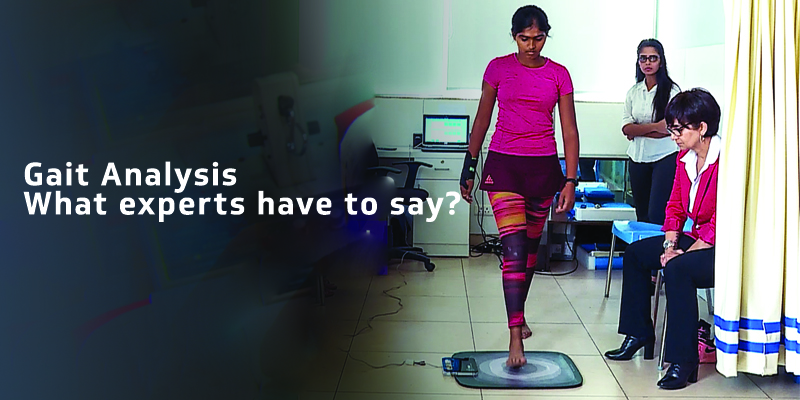
What comes to your mind when we talk about “Gait Analysis”? Many people think gait analysis is just watching someone walk or run and then suggesting shoes. How many of you have experienced this- you went to a sports shop to buy shoes and the salesperson asked you for which activity do you want shoes like walking, running or indoor activities. Then he suggested a pair of shoes that are more stable and cushioned for your requirement. And you think you have bought the best shoes and you will not have any biomechanical problems. Many people think this is Gait analysis.
Let us make you aware of what Gait Analysis actually is, how is it done and how beneficial it is for you? Gait Analysis is a scientific and technically-precise process. Let us know more in details:
What Is a Gait Analysis?
Gait analysis is the methodical study of human locomotion, using the eye and the brain of observers, amplified by instrumentation for measuring body movements, body mechanics, and the activity of muscles. Gait analysis is used to evaluate and help individuals with issues affecting their ability to walk or run. It is commonly used in sports field to help athletes run more efficiently and to identify posture or movement-related problems in people with injuries.
During gait analysis, your feet are considered as only one small piece of your biomechanical puzzle. The changes in the feet are merely a part of a whole-body, holistic and cohesive movement pattern. Running, like most other whole-body activities such as swimming or many field sports, is essentially a unique way of moving.
Your gait pattern can get affected due to number of factors including intrinsic factors like height, weight, sex, and age as well as extrinsic factors like footwear and surface. Some other factors may also play a role like emotions, body proportion, personality and neurological diseases and trauma.
What are walking or Gait abnormalities?
Abnormal or uncontrollable walking patterns are called Gait abnormalities. Gait refers to the pattern of walking. It can be caused due to genetics, diseases or injuries. They can affect the muscles, bones, joints and nerves of your body. There can be abnormalities in the entire leg or certain parts like an ankle or knee. Issues with the foot may also cause gait problems.
Depending on the cause, these can be temporary or long-term conditions. Severe walking abnormalities may require regular physical therapy and medical care.
Based on the symptoms, walking abnormalities are separated into five groups:
Scissors gait: A person with this type of gait walks with their legs bent slightly inward. Their knees and thighs may touch or hit each other in a scissor-like movement while walking.
Propulsive gait: A slouched posture characterizes this gait. A person with this gait walks with their head and neck pushed little forward.
Steppage gait: A person with this gait walks with toes pointing downward, causing their toes to rub the ground while walking.
Spastic gait: In this type of gait the person drags their feet while walking.
Waddling gait: A person with this gait shuffles from side to side when walking.
How is Gait Analysis performed?
During a Gait Analysis, movements of a person are analysed statically and dynamically while running on the treadmill. It provides a distinctive, personal movement “map”, which explains what all is happening within your body while walking—from kinesthetic awareness to individual levels of stability, mobility, flexibility and strength. The evaluation of all these different parameters taken together is what creates a complete picture of a person’s gait.
Gait analysis typically comprises of several steps, including a physical exam, video recording of gait and motion analysis. The procedure is usually performed in the presence of physical therapists, sports physician and a technician manning the instruments. During the procedure, the patient is asked to:
- Perform several movements to evaluate their range of motion, muscle spasticity, strength, and alignment
- Answer some questions, such as if they are experiencing any pain or discomfort while performing certain movements
- Walk on a treadmill with few sensors attached to different parts of their body, especially the ankles, hip and knees
- Walk on special device to assess the distribution of foot pressure
- The whole procedure usually takes a couple of hours to complete, depending on the patient’s capability and ease of performing the steps.
We have a fully equipped facility for Gait Analysis at RxDx Malleswaram and Whitefield. It is performed by highly qualified and skilled Sports Medicine Physician who is an expert in Pre-Participation Sports Evaluation. If you are looking for Gait analysis, then book an appointment at RxDx Malleswaram or Whitefield today!
Compiled By,
Dr Manjari Bansal– Content Writer, RxDx
Inputs given by,
Mr Ashwani Sinha – Chief Impact Officer, RxDx
For further details, please contact: 080-49261111, 6745-8111
Download RxDx Smart Healthcare App Now!!!



